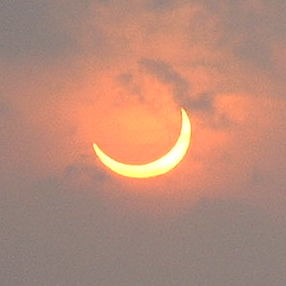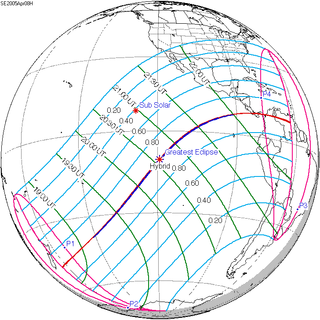| Solar eclipse of April 8, 2005 | |
|---|---|
 Partial from Naiguatá, Venezuela | |
| Type of eclipse | |
| Nature | Hybrid |
| Gamma | −0.3473 |
| Magnitude | 1.0074 |
| Maximum eclipse | |
| Duration | 42 s (0 min 42 s) |
| Coordinates | 10°36′S 119°00′W / 10.6°S 119°W |
| Max. width of band | 27 km (17 mi) |
| Times (UTC) | |
| Greatest eclipse | 20:36:51 |
| References | |
| Saros | 129 (51 of 80) |
| Catalog # (SE5000) | 9519 |
A total solar eclipse occurred at the Moon's ascending node of orbit on Friday, April 8, 2005,[1] with a magnitude of 1.0074. It was a hybrid event, a narrow total eclipse, and beginning and ending as an annular eclipse.[2] A solar eclipse occurs when the Moon passes between Earth and the Sun, thereby totally or partly obscuring the image of the Sun for a viewer on Earth. A total solar eclipse occurs when the Moon's apparent diameter is larger than the Sun's, blocking all direct sunlight, turning day into darkness. Totality occurs in a narrow path across Earth's surface, with the partial solar eclipse visible over a surrounding region thousands of kilometres wide. Occurring about 4.3 days after perigee (on April 4, 2005, at 12:10 UTC), the Moon's apparent diameter was larger.[3]
It was visible within a narrow corridor in the Pacific Ocean. The path of the eclipse started south of New Zealand and crossed the Pacific Ocean in a diagonal path and ended in the extreme northwestern part of South America. The total solar eclipse was not visible on any land, but the annular solar eclipse was visible in the southern tip of Puntarenas Province of Costa Rica, Panama, Colombia and Venezuela.[4] A partial eclipse was visible for parts of New Zealand, Oceania, West Antarctica, Mexico, Central America, the Caribbean, and western South America.
A partial eclipse was photographed from Nicaragua; in Bogota, several hundred schoolchildren watched the eclipse despite cloud cover.[5] In Cordoba, an expedition from Bogota's National University observed the eclipse.[5]
In Panama, where the eclipse was visible (and nearly total) from nearly the entire country, it was reported that hundreds of people had booked hotels to view it, including astronomers from the United States, Mexico, France, Belgium, Denmark, Iran and Spain.[6] While the totality of the eclipse occurred over the Pacific Ocean, it could be seen from some parts of the southern United States; it was reported that the southernmost parts of Florida had the best viewing conditions (with as much as 50% of the sun occluded),[2][7] although rainy conditions in part of the region meant the event was partially obscured.[5]
- ^ "April 8, 2005 Total Solar Eclipse". timeanddate. Retrieved 11 August 2024.
- ^ a b Cite error: The named reference
Pensacola News Journal 2005-04-08 p73was invoked but never defined (see the help page). - ^ "Moon Distances for London, United Kingdom, England". timeanddate. Retrieved 11 August 2024.
- ^ Cite error: The named reference
hBSAhwas invoked but never defined (see the help page). - ^ a b c Cite error: The named reference
DailyT20050409p7was invoked but never defined (see the help page). - ^ Cite error: The named reference
panwas invoked but never defined (see the help page). - ^ Cite error: The named reference
The Miami Herald 2005-04-08 p134was invoked but never defined (see the help page).
